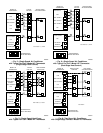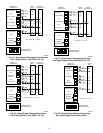stay on and turn Cool Stage 1 on. For actual outputs, refer to Table
2, making sure the correct row from the table is selected. To turn
off, raise cooling set point above the room temperature. Cool Stage
1 and the triangle will turn off within a few seconds.
If system has 2 cooling stages, it will start on Cool Stage 1 and
proceed to Cool Stage 2, 15 minutes later due to a staging timer
which requires 15 minutes between successive stages. The IN-
CREASE TEMPERATURE button (up and FAN buttons) cannot
be used to defeat this timer. This timer can be defeated by reducing
the set point to more than 5° below room temperature, bringing on
a Cool Stage 2 demand within 5 seconds. Remember: 2 stage
cooling units often have a 1 minute off time between lo and high,
so the thermostat’s demand will not show immediately as a change
in the outdoor unit. It will show immediately as an increase in the
indoor fan speed.
TO TEST HEATING:
Press MODE button until HEAT icon under it turns on. Press up
button until HEAT set point (LOWER right 2 digit display with
HEAT now flashing under it) is 2° or 3° (not more) above room
temperature. This will create a Heat Stage 1 demand. A small
triangle to the left of this HEAT icon will flash or come on
continually. Flashing means the equipment is going to turn on but
is presently being held off by a system timer. (See Operational
Information for timer descriptions.) Defeat timer by pressing
INCREASE TEMPERATURE button (up and FAN buttons to-
gether). This will make the triangle stay on and turn on Heat Stage
1. To turn off, reduce heating set point below room temperature.
The heating and the triangle will turn off within a few seconds.
If the system has multiple heat stages, it will start on Heat Stage 1
and proceed to Heat Stage 2, 15 minutes later due to a staging
timer which requires 15 minutes between successive stages. The
INCREASE TEMPERATURE button (up and FAN buttons)
cannot be used to defeat this timer. If set point is raised more than
5° above room temperature, the staging timer is defeated and the
thermostat will call for higher stages within 5 sec. Use this method
if there are only 2 stages of heat. If more than 2 stages of heat are
available, do not use this method because once the demand
exceeds 5°, the thermostat may jump to the highest stage. With
more than 2 stages available, let the timer advance one stage every
15 minutes.
TO TEST EMERGENCY HEAT (heat pump systems only):
To test, press MODE button until EHEAT icon turns on. This will
allow operation of auxiliary heat only. Raising set point above
room temperature will turn on the first stage of auxiliary heating
(W/W1). Raising set point more than 5° above room temperature
will advance to full heat, if it is available (O/W2 or Y1/W2 will
come on—see Table 2). Reducing set point below room tempera-
ture will turn all heat off.
Step 6—Final Settings
1. Assuming the system is to be left in operation after the
installation is complete, use MODE button to select between
HEAT, COOL, EHEAT, or AUTO to provide the desired
operation of heating, cooling, or both.
2. The default set points and programmed schedule conform to
the Energy Star requirements of the U.S. Department of
Energy for both heating and cooling. These provide energy
saving temperature settings.
3. Turn on HOLD if fixed set points are to be used. If the
programmed schedule is to be used, make sure the HOLD icon
is off.
4. For further information on temperature selection and program-
ming, refer to Homeowner’s Manual.
5. If AUTO mode is to be used, be sure both heat and cool set
points are properly adjusted.
6. The FAN button may be used to select between AUTO (fan on
only with equipment) and FAN (fan on continuously) fan
modes.
Step 7—Checklist
1. Put away tools and instruments, and clean up debris.
2. Review Homeowner’s Guide with owner.
3. Leave literature packet with owner.
4. Fill out and return survey card.
5
→
→


















